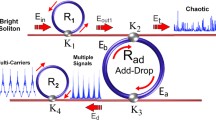Abstract
An innovative dynamically reconfigurable radio-over-fiber (RoF) network equipped with an intelligent medium access control (MAC) protocol is proposed to provide broadband access to train passengers in railway high-speed mobile applications. The proposed RoF network architecture is based on a reconfigurable control station and remote access unit (RAU) that is equipped with a fixed filter and tunable filter. The proposed hybrid frequency-division multiplexing/time division multiple access (FDM/TDMA) based MAC protocol realizes failure detection/recovery and dynamic wavelength allocation to remote access units. Simulation result shows that with the proposed MAC protocol, the control station can detect failures and recover and dynamic wavelength allocation can increase the wavelength resource utilization to maintain network performance.
Similar content being viewed by others

References
Greve F D, Lannoo B, Perters L, et al. FAMOUS: A network architecture for delivering multimedia services to fast moving users. J Wirel Pers Commun, 2005, 33: 281–304
Fokum D T, Frost V S. A survey on methods for broadband internet access on trains. IEEE Commun Survey Tutor, 2010, 12: 1–15
Scalise S, Mura R, Mignone V. Air interfaces for satellite based digital TV broadcasting in the railway environment. IEEE Trans Broadcast, 2006, 52: 158–166
Verstrepen L, Joseph W, Tanghe E, et al. Making a well-founded choice of the wireless technology for train-to-wayside data services. In: Proc 9th Conf Telecommunications Internet and Media Technology Economics, 2010. 1–7
Larrode M, Koonen A M J. All-fiber full-duplex multimode wavelength-division-multiplexing network for radio-over-multimode-fiber distribution of broadband wireless services. IEEE Trans Microw Theory Tech, 2008, 56: 248–255
Mitchell J E. Radio over fiber networks: advances and challenges. In: Proc Europe Conference on Optical Communication (ECOC). Vienna, Austria, 2009. paper: 2.4.5
Kim H B, Emmelmann M, Rathke B, et al. A radio over fiber network architecture for road vehicle communication systems. In: Proc IEEE 61st Vehicular Technology Conference, Spring, 2005. 2920–2924
Lannoo B, Colle D, Pickavet M, et al. Radio-over-fiber-based solution to provide broadband internet access to train passengers. IEEE Commun Mag, 2007, 45: 56–62
Pleros N, Vyrsokinos K, Tsagkaris K, et al. A 60GHz radio-over-fiber network architecture for seamless communication with high mobility. IEEE J Lightw Technol, 2009, 27: 1957–1967
Hsueh Y T, Huang M F, Jiang M, et al. A novel wireless over fiber access architecture employing moving chain cells and RoF technique for broadband wireless applications on the train environment. In: Proc IEEE Optical Fiber Conference, 2011. paper: OWT3
Author information
Authors and Affiliations
Corresponding author
Rights and permissions
About this article
Cite this article
Shen, X., Xu, K., Sun, X. et al. Dynamically reconfigurable radio-over-fiber network with medium access control protocol to provide network access to train passengers. Sci. China Inf. Sci. 56, 1–10 (2013). https://doi.org/10.1007/s11432-012-4667-7
Received:
Accepted:
Published:
Issue Date:
DOI: https://doi.org/10.1007/s11432-012-4667-7



